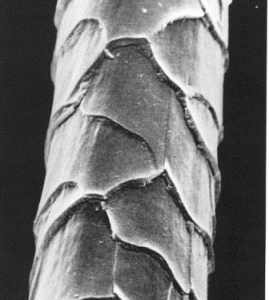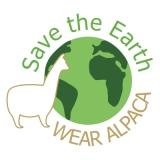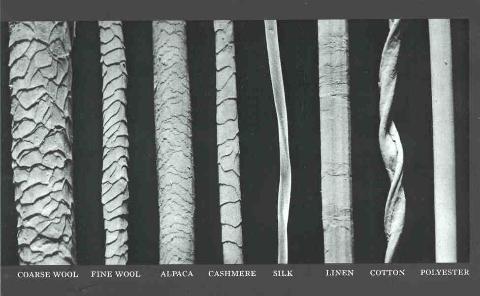For years wool has been used to manufacture garments of all kinds. From socks to blazers, wool has been the textile of choice for many individuals. Its warmth and durability has made it a favorite for consumers all over the world. The main issue for some has been the obvious issues with wool such as its itchiness due to the structural makeup of the wool fiber. In the picture below you can  see a wool fiber at the microscopic level.
see a wool fiber at the microscopic level.
In the picture it is easy to see each individual scale on the wool fiber. Wool has large scales that, at a microscopic level, are raised fairly high causing them to “catch” on your skin thus causing that itch. These individual raised scales cause the individual wool fibers to lock into one another, a definite benefit however, they also catch dirt and grit and can cause the wool to break down sooner if not taken care of. This also make wool a bad choice for next-to-skin wear.
Click here now to get non-chemically treated Alpaca Socks!
When compared to alpaca fiber you can see that the scales of the alpaca fiber are much smaller than those of many commonly used fibers.
The scales on the alpaca fiber are much smaller and do not rise up as high. This smaller scale greatly reduces the itch factor and makes for a stronger fiber. Wearing quality alpaca next to your skin should not cause any irritation due to itching. Many people have even compared alpaca fleece to cashmere. When you look at the picture above you may see why.
To combat some of these negative features of wool some clothing lines are now being promoted as “superwashed” for next-to-skin capabilities by removing the wool’s lanolin and barbs. According to Textile Chemicals: Environmental Data and Facts, the superwashed wool is treated with synthetic resins (polyamide / epichlorohydrine or polyurethane), a method that can include such chemicals as chlorine and hypochlorous acid, sulphuric acid, sodium hypochlorite, alkali metal salts of dichloroisocyanuric acid (DCCA) and an acid-stable wetting agent. The chlorination process for wool has lead to enormous environmental problems. Alpaca now offers an eco-friendly alternative to natural fiber active wear
When I read about the chemicals used in the new wool products that have gained some popularity in the market place I was shocked. I could not imagine placing these new products that have been infused with these harsh chemicals on my body, even if they were only socks.
The good news is alpaca fiber does not have to be treated with any harsh chemicals so that you can wear it next to your skin. This along with the many other beneficial characteristics of alpaca that has been described in my other posts make alpaca a top choice for a natural fiber that is strong, soft and definitely easy on the environment.
I don’t know about you, but when I am looking for something to keep my feet warm having chemically treated materials next to my skin just does not make me feel comfortable. Knowing that alpaca socks do not have to be treated to make them feel soft or to remove any allergen gives me piece of mind that me and my family can where a product that is not potentially dangerous to our health. This once again proves to me that Alpaca Socks, or any garment made from Alpaca, is the best choice.
Knowing that alpaca socks do not have to be treated to make them feel soft or to remove any allergen gives me piece of mind that me and my family can where a product that is not potentially dangerous to our health. This once again proves to me that Alpaca Socks, or any garment made from Alpaca, is the best choice.
Click here now to get non-chemically treated Alpaca Socks!
-Jonothan
